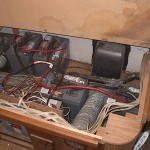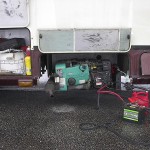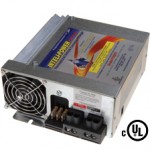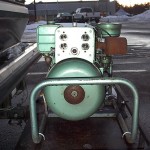Started 15 September 2012
Or Up Grades, how they are working and plans for surviving winter 2012-2013
We’ve been living and working in a day use park since July so we’re enjoying a level concrete pad,
never ending water, electricity and sewer. Well almost. The park well pump had issues since resolved so we kept our water tank full and the electricity went out for a couple of days after a storm blew through and felled some trees onto the power lines. The four GC-15 batteries we installed along with the original pair of group 27s kept the lights on and I don’t think we bothered to start the generator to power the microwave. Air-conditioning! While a test, in a parking lot during a heat wave in June showed that it’s prohibitively expensive to run the air-conditioner from the generator having an unlimited supply of free electricity has been great! One air-conditioner can’t handle the sun load but it does keep the air dry and that’s a big help and once the sun goes down the inside temperature comes down quickly. If we lived in a warmer climate maybe we’d need a second air-conditioner but I think for now I’d rather have the roof vent in the bedroom and the fresh air it provides. So the purchase and installation of a used air-conditioner has been a good thing.
The GC-15 batteries have been installed sans clamps under the bunk where the hot water heater, and main electrical panel live.

Four GC-15 batteries wired into the house. The batteries are not vented to the outside and are not clamped down.
The Progressive Dynamics three-stage battery charger and power converter has been mounted vertically with the current shunt along side. The only thing not bolted down besides the batteries is the 50A self resetting circuit breaker for the power from the batteries. We’re still working on the survival part of RV life but I know that both leads from the batteries need to be fused. Why both? And why fused? Because a short circuit in either side, hot or ground, positive or negative will lead to a fire.

Our 3-stage 60 ampere battery charger is mounted vertically on the back of the board that holds the fuses and circuit breakers.
Living with the PD 9260c 60 amp battery charger has been almost transparent. Except when the incandescent lights suddenly become brighter. The PD 9260c is a 3-stage battery charger and power converter, meaning it has Bulk or Boost (14.4V), Normal (13.6V) and Float or Storage (13.2V) charging voltages. Every 21 hours the PD 9260c goes from Float to Bulk for 15 minutes to stir the electrolyte in the batteries and keep it from forming layers of different densities, you know, stratifying.
A 4-stage battery charger add a fourth even higher voltage called Equalize. On some arcane schedule or when your measurements of the specific gravity in all of the cells of the batteries don’t come up with the same number, the Equalize voltage boils the batteries to bring all of the battery cells to the same level of charge. Progressive Dynamics tells you about the equalizing charge but the model we bought doesn’t have the fourth voltage. Three really great thing about the PD9260 is that it runs on a wide range of voltages, anywhere from 90-135VAC and always with the correct DC voltage coming out the other end. This was a critical need with our first generator.
We started last winter with a 1965 Dayton alternator capable of a real 2.5 KW of output mounted on the trailer hitch and it served us well.
But it only ran a couple of hours on each tank of fuel and I had to go outside to fill and start it when we needed 110 VAC. Using Lynn’s skills at sourcing good stuff cheap we acquired a 4KW Onan emerald II with issues. I cleaned some of the electric connections, the Do-Not-Touch emissions carburetor and re-installed the I-was-lucky-they-were-still-there electric choke and vacuum pull-off. I’ve given the 1800 RPM engine an oil change with a new oil filter and found the missing carburetor heater tube on e-Bay. We are lucky in that the Rockwood came with the generator change over relay. Not so much because we are worried about back-feeding the shore power by accident, but because the change-over relay gave us a place to permanently wire in the generator output and gives the Onan 30 seconds to stabilize before connecting the 110VAC to the house. We were running the Dayton by plugging the house into the Dayton. If I left it plugged in the slow rise in voltage as the generator came up to speed gave issues with the microwave oven’s electronics.

This is how we ran our Onan after first mounting it in the generator bay, using an external battery and fuel tank.
I’ve started running the Onan for 1/2 hour each week while we’re still living with shore power “just for exercise” and my game plan going into the winter is to run the Onan 1 hour in the morning for battery charging and breakfast. I’ve gotten used to my microwave’d oatmeal and an electric toaster. I want to source the double throw momentary rocker switch and connectors so that I can start the Onan from inside, but for the time being, as they say “that’s not a deal breaker.”


